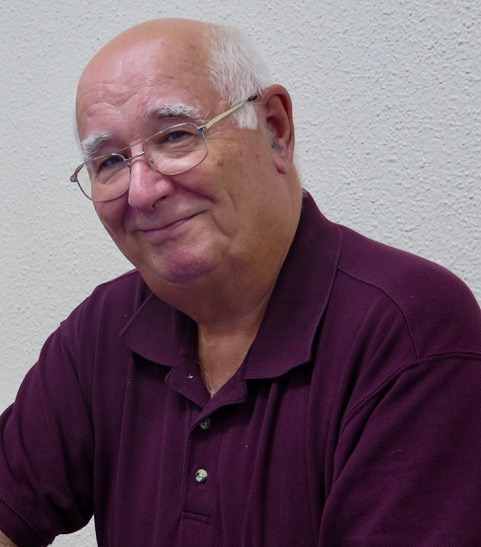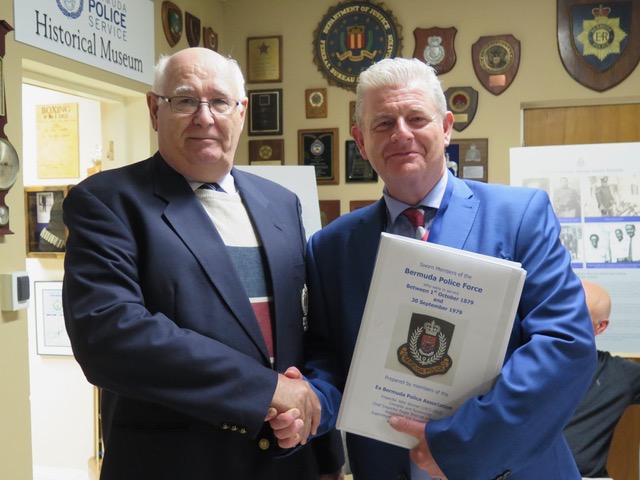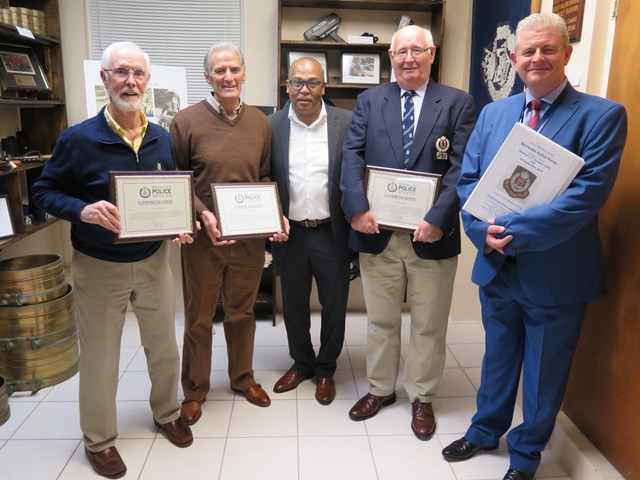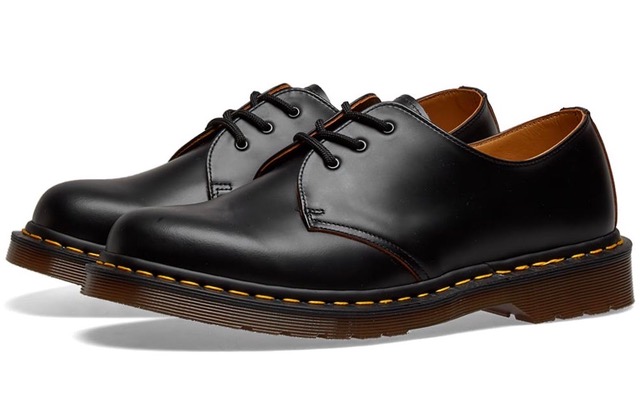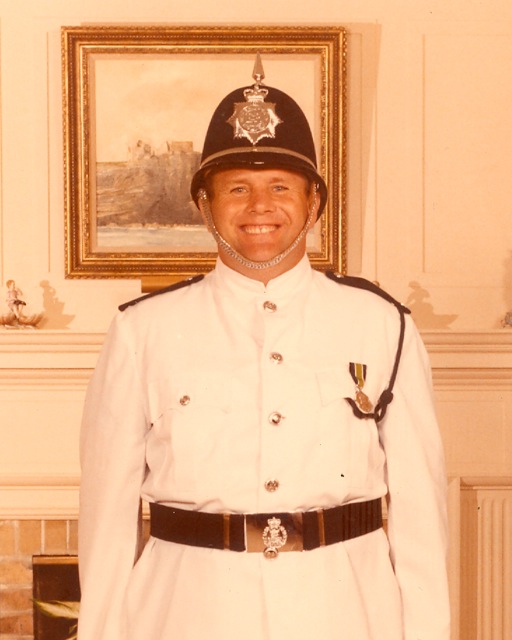The Story of the Saga of the Rubber-Soled Shoes.
Exhibit 'A' Doc Martin's rubber soled shoes
This “comedy of errors” began in September 1978, when the Bermuda Police planned to open a new Police station at the Airport and, as Eastern didn’t have sufficient personnel at the time to run two stations, personnel had to be recruited from other divisions to make up the shortage.
 P.C. Davie Kerr in Operations Room
P.C. Davie Kerr in Operations Room
At the time I was living in Warwick East and working in Somerset, and I was one of the two people being considered for a transfer from West to East. The other one was Eric Ingemann, who at the time lived right out at the tip of Spanish Point and had a daily 30-mile round trip to & from work. His family home was near the Airport, his father had just died, and everyone reckoned that he’d be the obvious choice to go East. In fact, he was such an obvious choice that they overlooked him altogether and sent me instead! I’d made no secret of the fact that I wasn’t thrilled with the idea of going East, but I said that I’d give it a shot and, if it didn’t work out, I’d try and switch with someone who really, really wanted to be there. The obvious switch candidate was a fellow Scot called Gordon Farquhar, who’d recently been moved from East to the Ops Room and would have given his right arm to get back East, and I’d previously worked in the Ops Room anyway, so I’d have had no problem with that move.
Anyway, about a week before I was due to move, I phoned OIC East (Chief Inspector Harold Moniz), and the conversation was roughly as follows:-
“Morning Sir, PC Kerr here. I’m told that I’m coming down to join you next week: where and when do you want me?”
“Ah, morning Davie. You’re going to the Airport, where you’ll start Lates on Monday under Sgt Mackenzie” (yes, the one and only “Spider”). “Do you know where the Airport Police Station is?”
“No Sir, I’m afraid I don’t: I haven’t been to the Airport for months.”
“No problem. Just drive into the main car park, and you’ll see a big sign that says ‘Airport Police Station’.”
“Fine Sir; see you next week.” And that was that (or so I thought!).
About 1530 on the Monday in question (18 Sep 78), I drove into the main car park, parked my vehicle, and looked around for the big sign saying ‘Airport Police Station.’ Nothing: not even a small sign saying ‘Airport Police Station’! I wandered around for a few minutes, but with no success. I eventually landed up in the main airline check-in area, and a mate of mine with whom I used to play football said, “Hi, Davie: what brings you down this way?”
“As a matter of fact,” I said, “I’m looking for the Police Station!”
“Oh, you don’t know where it is? Come with me.” So off we went towards the Police Station. On the way there, a voice from behind me called, “Davieee! Where are you going?”
“Down to the Police Station,” I answered.
“Wait for meee!” This was Spider: he didn’t know where the Police Station was either!
As we were the first two there from the Late Shift, Spider (whom I’d known for years as we used to play football together) said, “Davie, you’re first here, so I’ll give you Station duty for the time being until we see who else turns up.”
“OK Sarge, no sweat.” So there I was, Station Constable of Station X-ray.
As it was the first day of the new Police Station being operational, Commissioner of Police Nobby Clarke, OIC East Harold Moniz, and OIC Airport Inspector “Cuddly” Dudley Swan were all buzzing around making sure that everything was moving smoothly, and, Bermuda being what it is for stories, it wasn’t long before Customs were telling anyone and everyone the story about the two Policemen who couldn’t find the Police Station! Nobby naturally wasn’t too happy about this, and he had a face like thunder by the time he and the other two came into the station about 1715. Spider had deployed his troops and “done a runner” by then, so I was on my own when the Three Amigos appeared. I stood smartly to attention (as was the custom in those days in the presence of senior officers!) and said, “Good afternoon Sir!”
Nobby growled something back, and they all went into Dudley’s office. A few minutes later they all came out again, and Nobby growled at me, “I understand you don’t like it down here, huh?”
“Well, Sir,” I replied as tactfully as I could, “it’s a bit of a long haul down from Warwick.”
“OK, I’ll fix that. You’ll be walking the beat in Hamilton tomorrow. What do you think of that idea?”
“Please Sir, not tomorrow Sir, it’s my birthday tomorrow Sir!”
“See if I care! Mr Swan! Call Mr McMaster” (the then Deputy Commissioner) “and tell him that Kerr’s going to Hamilton tomorrow to walk the beat!” Five minutes later came the return phone call: Kerr’s going to Hamilton tomorrow to walk the beat! You’ve heard of “90 Minutes at Entebbe”? I was “90 Minutes at the Airport”!
The following day (which actually was my birthday, my 33rd!), I was due in court at 0900 to give evidence in a Breach of the Peace case left over from my time up West. I knew that I was going to be walking the beat indefinitely as of that day, so I decided to wear a pair of previously bought Doctor Marten’s rubber-soled shoes for comfort instead of the leather-soled clodhoppers that were then standard Stores issue. After I’d been in court (which only took a couple of minutes, as the defendant changed his plea to “Guilty”), I went over to Hamilton Police Station to collect my new locker key for starting Lates that afternoon, and, standing right outside his office which was then right next to the Divisional Clerk’s office, was Superintendent OIC Uniform branch, Frederick “Penny” Bean, chatting to a guy called Reg White from PWD. As I was in uniform, I saluted him on the way past and said, “Good morning, Sir.”
“Morning, Constable Kerr,” was the rather frosty reply. I went on into the Div Clerk’s office, collected my key, had a bit of chat to the clerk (Sgt Derek Fletcher), and left again. Penny was still standing chatting outside his office. I saluted again on the way past, and was about to leave the outer office when the voice came.
“Constable Kerr!”
“Sir?”
“I don’t like the way your sunglasses are hanging round your neck on that piece of string. Either put them on properly, or take them off altogether.”
“Very good Sir.” And I was just putting them on under my crash helmet when he spoke again.
“By the way, are those issue shoes you’re wearing?”
Well, they weren’t, so I replied, “No, Sir.”
“Come into my office. Sit down.” And he summoned his trusty sidekick, OIC Central Chief Inspector Harry Lister, and said to him, “Look at Constable Kerr’s shoes.”
Harry looked at my shoes from various angles for about 30 seconds, and you could almost see the light bulb clicking on as he eventually said, “I don’t think they’re regulation.”
Penny’s next action was to phone Somerset. “Pull PC Kerr’s travelling file for me,” he said, “and see if there are any entries therein about him being reprimanded for wearing unauthorised items of uniform.” There was one such entry, caused by me turning up for Nights one night during a tropical storm (knowing full well that, if anyone had to stand out in the rain and direct traffic round any obstacles in the road, it was probably going to be Mummy Kerr’s wee boy!) with an old but waterproof ‘Belstaff’ motorcycle jacket for protection instead of the Police issue sprinkle-proof raincoat, and Penny seized on this.
He then phoned the Police Stores, and said, “When did PC Kerr last draw a pair of Police shoes?” The reply came back, “January, 1975”, and this was now September, 1978! As far as Penny was concerned, this was the last straw: he decreed that I was being “subversive to discipline”, “detrimental to morale”, and all that other stuff, and ordered me to report to the Day Shift Sgt who would escort me (yes, ESCORT me!) to Stores, supervise the issue to me of a pair of leather-soled Police shoes, and impound my rubber-soled shoes as Exhibits A and B for the forthcoming disciplinary enquiry
All he had to do was say to me, “PC Kerr, those are not issue shoes. When you come on Lates today, you better be wearing a pair of issue shoes, and don’t wear these ones in uniform again.”
I duly went downstairs and reported to the said Day Shift Sgt, one Derek Jenkinson, who was (not unnaturally!) cracking himself laughing! “Davie,” he said, “only you could drop yourself in something like this. So that you don’t need to come back down to Hamilton after we’ve been to stores, I’m going to take a big risk with you and let you ride your bike up there, and trust you not to change your shoes en route!” So off we went up to Stores, where I was issued with one pair of leather-soled clodhoppers and my DMs were duly handed over for safe-keeping, to the accompaniment of much ribaldry from Jenks and OIC Stores, PC Derek Smith.
The following week Sgt Les Waddell came up to me and said, “Davie, I’m sorry to have to do this, but I’ve been given the job of investigating your case, and I’m afraid I have to serve you a Second Schedule” (Notice of Disciplinary Proceedings) “about the shoes.”
“No problem Sarge,” I answered, and that was that.
PC George Rushe (with whom I’d joined the Police back in November ’66 now also regrettably deceased), had had his own personal experiences with Supt Bean, and got to hear about this case. He came to me one day and said, “Davie, let me defend you on this: I think we can have this man over a barrel!”
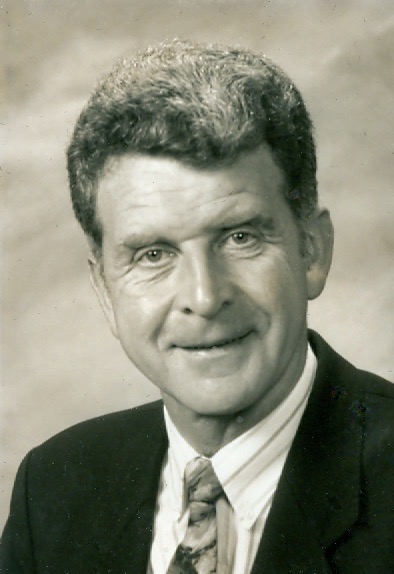 George Rushe
George Rushe
“Right,” I said, “you’re on!” And so it was arranged.
The hearing was set for the Long Room up at Police HQ for 0900 on Wednesday, 15 Nov 78, with Supt Maurice “Syke” Smith presiding. Harry Lister was the Prosecutor, as the alleged offence had happened in his division, and his first words were, “Right, Constable Kerr, have you got your cap?”
“No Sir, I haven’t,” was my reply. “I came here on my motorcycle so I wore a crash-helmet, and I was under the impression that the defence was always bare-headed at disciplinary hearings anyway, so I didn’t bring any other headgear with me.”
“No excuse: should have a hat,” was Penny’s contribution. My boy George casually flipped open his copy of Force Standing Instructions (hereafter referred to as FSI's) at the exact page where it said that, at all disciplinary proceedings, the prosecution would wear headgear and the defence would be bare-headed, and showed it to Harry. “Look, Sir, it’s right here!” Harry wasn’t greatly fussed, and simply marched me in bare-headed in front of Syke Smith, who read out the charge and asked me for my plea.
“With all due respect Sir, Not Guilty,” was my reply.
No problem. First Prosecution witness in was Penny Bean, who had in the meantime somehow managed to mislay his hat! After he’d given his evidence, my boy George languidly rose to his feet and opened his remarks by saying, “We shall overlook the fact that this Prosecution witness is improperly dressed in that he is bare-headed. Superintendent Bean: I trust you had some very good reason for believing that the shoes allegedly worn by PC Kerr on the date in question were not issue shoes?”
“Yes!” was Penny’s reply.
“I see. Would it then be reasonable to assume that, if these shoes were not issue shoes, they would be Constable Kerr’s own property?”
“Well, yes.”
“And do you know how many pairs of shoes Constable Kerr owns?”
“No.”
“Oh. Is it not just possible, then, that by impounding this pair of shoes you may have deprived Constable Kerr of his only pair of civilian footwear?”
Stunned silence, during which I was thinking, 'Oh, SH*T!' George then slid the knife in by saying, “OK, we’ll leave that point. Can you quote me any section of either Force Standing Instructions, or the Force Discipline Code, which allows you to impound an officer’s personal property?”
“Oh, there’s nothing actually written down, but everyone knows that you must have the evidence readily available in such matters.”
George gently twisted the knife. “Answer the question, please. Can you quote me any….......?”
“Are you being insubordinate, Constable Rushe?”
Syke Smith, who had hardly said a word until then, said, “I am the Presiding Officer in this case, and I shall decide whether or not Constable Rushe is being insubordinate. Carry on, Constable Rushe!”
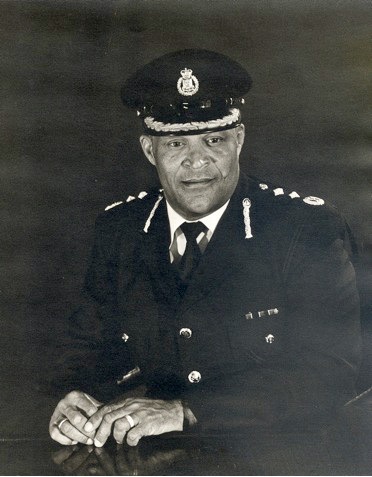 Presiding Officer - Syke Smith
Presiding Officer - Syke Smith
George threw his hands in the air in mock horror, said, “I can’t conduct a proper defence under these circumstances,” and sat down. Penny was then stood down, and I heard within the week from no less than three separate and, in my opinion, reliable sources that the then Deputy Commissioner, one Alf Morris, had been in his office listening to the proceedings next door, and had had Penny in front of him that afternoon to tell him exactly what he thought of his performance during the hearing!
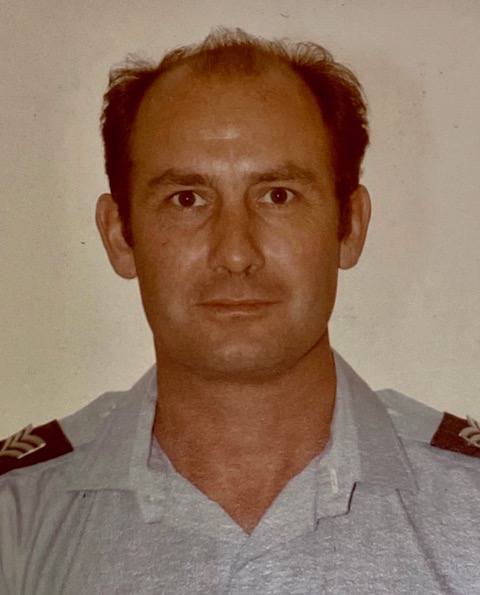 Sgt. Derek Jenkinson
Sgt. Derek Jenkinson
Next witness was Sgt Derek Jenkinson, who had just become a daddy for the first time, was on paternity leave, and didn’t really want to be anywhere NEAR Headquarters right about then! It didn’t hurt my cause that he & I were mates. He gave his evidence as unhelpfully to the Prosecution as possible, and then my boy George opened up again.
“Sgt Jenkinson, am I correct in saying that you’ve been a sergeant for several years now?”
“Yes.”
“And, during that time, have you frequently paraded a watch of men in front of you to commence their tour of duty?”
“Yes.”
“And, among other things, do you check their appearance before they go out on patrol?”
“Yes.”
“I see. I show you these shoes. Supposing someone was to parade in front of you while wearing these shoes, would you have any reason to object to them, assuming of course that they were clean?”
“No.”
“Thank you. Would you please read out this section of FSIs concerning Summer Uniform?”
So Jenks read out, “Constables and Sergeants in Summer Uniform will wear pale blue short-sleeved shirts of the approved pattern, navy blue shorts, navy blue knee-length socks, navy blue webbing belt with handcuff pouch, and navy blue lanyard on the left shoulder.”
“And would you now please read out this next section concerning footwear?”
So Jenks read out, “All ranks of the Force, in all uniforms, will wear plain-toed black leather shoes, with the exception of Senior Officers in ceremonial uniform who will wear approved pattern boots.”
“Thank you, Sgt Jenkinson. I show you these shoes again. Are these the shoes worn by PC Kerr on the date in question?”
“Yes.”
“Are they plain-toed?”
“Yes.”
“Are they black?”
“Yes.”
“Are they leather?”
“Yes.”
“Thank you. No further questions.” And that was the Prosecution’s case shot to ribbons right there, as I was wearing precisely what FSI's said I ought to be wearing!
Next witness was Derek Smith from Stores, who testified that rubber-soled DMs were in fact issued to certain departments of the Force, namely Marine Section, Parishes, Cycle Squad, Motor Cycle Section, and the Garage. He further testified that the only difference between my DM's and the Stores issue DM's was that I had the heavy-duty 15mm thick soles on mine, as opposed to the standard 12mm thick soles on the Stores ones. Syke then said, “Right, judgment here at 0900 Friday,” and adjourned the proceedings for the day.
On the Friday morning, his judgment was basically as follows:- “PC Kerr has never denied wearing these shoes, and has freely admitted to buying them whilst on leave in the United Kingdom. It is therefore established, beyond any shadow of a doubt, that they are not issue shoes. However, PC Kerr has not been charged with wearing non-issue shoes: he has been charged with wearing non-regulation shoes. FSI's state, quite clearly, that the footwear worn by all ranks of the Force in all uniforms will be plain-toed black leather shoes. This description fits PC Kerr’s shoes to a T, and I must therefore find him Not Guilty. Case dismissed.”
I subsequently asked Nobby Clarke if I could therefore have official permission to carry on wearing my DM's, and such permission was duly granted. Since then DMs have become standard issue in the Bermuda Police, because they’re lighter, stronger, more flexible, have better-gripping soles, and are less expensive than the old leather-soled jobs.
When Nobby retired in 1981, Penny Bean became Commissioner of Police, after which he allegedly made the famous remark that “PC Kerr and I now have one thing in common: we’ve both gone as high as we’re going in this Police Force!” Hearing that, do you wonder that I spent my entire 36 years’ service as PC (as in “Permanent Constable”) Kerr?
Nobby had the last laugh though. His final act before retiring in 1981 was to promote George Rushe to Sergeant, on the most appropriate date: April Fools' Day!
Penny Bean was Supt Central from Sep ’78 to Apr ’79, during which period he tried to nail my hide to the wall an average of once a month with a litany of disciplinary charges. I’m pleased to report that he finished with a record of played 7, lost 7! You would not believe the number of people who said to me during that period something like, “Not wishing anything bad on you, Davie, but I’m glad you’re in Central just now as you’re taking the heat off the rest of us! How do you manage, with this man breathing down your neck all the time?”
“Well, my conscience is clear,” I said. “If he wants to waste his time trying to conjure up imaginary offences with which to charge me, that’s his problem!”
P.C. Davie Kerr attends Government House in 1986 to receive
his Colonial Police Medal for Long Service and Good Conduct.
Anyway, there you have the facts, as well as I can remember them 30-odd years later, surrounding the Story of the Saga of the Rubber-Soled Shoes! It’s a cracker, isn’t it? Only in Bermuda!
_______________________________________________
Editors note - P.C. Davie Kerr passed his promotion exams in February 1971, and in March 1986 he received a Queen's Commendation for Bravery. He retired in 2000 after serving in the Bermuda Police Service for 34 years. Throughout his career he was well known for having a "photographic memory" especially for names and numbers. Even after all these years he can still instantly recall the names of many of the officers he served with AND their badge numbers! Davie is our #1 source for the names of our old friends and colleagues who are featured in our "Who, Where and When" column.
You can read his biography in our Then and Now column at http://recovery.expobermuda.com/index.php/tan/16-dkerr

